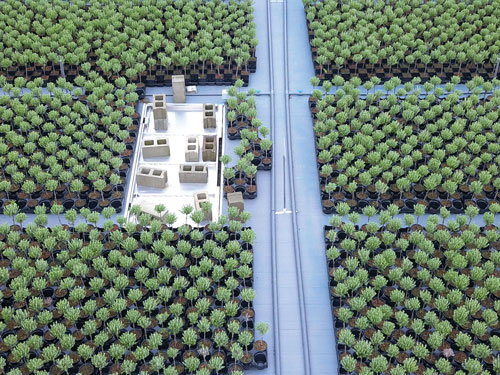5/1/2022
The “Weigh” to Go
Stephanie Saccomano

“Moisture management” is a term often slung around during crop-walk conversations with our Growing Team. It’s inevitable. Regardless of what the problem (or success!) is before us, we often end up discussing irrigation decisions and their resulting impacts on the rootzone. What went well? What could have been done better? Are we as individuals making decisions with the same
reasoning?
Pictured: One of Qualitree’s fields where they weigh their plants after watering.
As this perpetual conversation continues over the years, we collaborate and improve on our strategies. The focus of the last year or so has been “narrowing the band.” The objective: reduce overwatering, allow more air in the substrate and create more opportunities to fertigate. We’ve seen success in shorter durations and, if necessary, more frequent cycles. This short-and-sweet approach has punctuated the need for vigilance and irrigation decisions with intention. It sounds great on paper, but the reality of it means that while we’d committed to more deliberate actions, we were also committing to more time and energy in crop checks, with a little more worry in between. A narrower band meant a smaller buffer between “container capacity” and “too dry” ... a buffer that could easily be melted by an unexpected weather change or a delay due to broken irrigation.
Various discussions and articles brought forward the idea of scaling our crop weights for moisture management. It had been mentioned periodically over the years, and at times employed for detailed study or porosity testing. But the task at hand became implementing this for daily use. As planning was already underway for Erfgoed field installation outside, it was an opportunity to sidle in plans for scale plots among the zones. We tested the concept, then really went for it.
It didn’t take too long after setup to reap the benefits. Where before an irrigation decision was solely a matter of experiential inferences, physical evaluation and gut-feel, the scale method gave us quantifiable information. The ability to remote access our control program and see these weight values also allowed us some peace of mind. We learned new things about how our crops were taking up water, and with the auto-trigger of irrigation based on thresholds, it felt very “plug-and-play.” Less worry, more fun. We poured over graphical data of what crops were triggering and when. We learned some zones dried down a little faster due to field position and could address those outliers. We could also easily see the impact of rainfall.
Now, I’m enthusiastic about this setup, but I would be remiss if I didn’t also elaborate on any implementation pain points. First of all, the setup of the scale platforms in the fields was clunky. We had issues with moisture-proofing electronics. Calibration involved lugging 25-kg. fertilizer bags out to each platform. Then, once the hardware was good to go, we had to get crafty with Argus software. How to allow for flexible irrigation programming? Based on the crop, we wanted to group multiple scale zones into one irrigation schedule. And we wanted that irrigation schedule to trigger based off of an average of all scale readings within it. But those zones could have different crops at any given time of the year and we would need to shuffle them among schedules.
After some noodling and learning more about what we could program into Argus, we nailed it down, documented the “how-to” and finally gave it a serious test drive. We quickly saw the benefits, though we realized this new system meant changes for more than just the section growers. The water could turn on at inconvenient times around operational working crews. Or shipping teams would remove plants from scales and throw off the readings. Things we had to navigate, but not deal-breakers given the benefits.
As more outdoors field construction is planned for the future, we intend to continue including scale platforms. In fact, we’ve gotten so fond of this approach that we’re exploring how we could use it in other location scenarios. While we’re obviously a fan of data-driven growing, huge benefits that cannot be overlooked are the time and stress saved. This allows more headspace for curiosity, big-picture thinking and fun. It’s simply the way to go. GT
Stephanie Saccomano is Indoor Spaces Lead Grower for Qualitree Propagators in Rosedale, British Columbia, Canada.